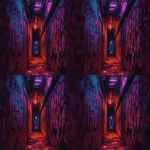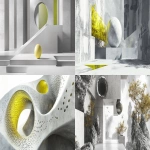Explore the Best AI Image Gallery

Beyond the Brush: How Edge Computing is Empowering Creative Expression
The creative landscape is on the cusp of a seismic shift, driven by the transformative power of edge computing. This technology, which processes data closer to its source, is poised to revolutionize how artists, designers, and innovators create, collaborate, and interact with their audiences.
Unleashing Real-Time Creativity
Imagine a world where digital art responds instantly to your movements, or where collaborative design projects unfold seamlessly across continents. Edge computing makes this vision a reality by enabling:
- Real-time Collaboration: Artists can work together on projects in real time, regardless of their location. Changes made by one collaborator are instantly reflected for everyone involved, fostering a more dynamic and collaborative creative process.
- Responsive Art Installations: Edge computing empowers artists to create interactive installations that respond dynamically to viewers presence and movements. This fosters a sense of immediacy and engagement, blurring the lines between art and audience.
Immersive Experiences
Edge computing paves the way for captivating immersive experiences that transport audiences into new worlds:
- Virtual Reality (VR) Enhancements: By processing data locally, edge computing reduces latency and enhances the realism of VR experiences. This allows artists to create more detailed and immersive virtual environments, making them more engaging for users.
- Augmented Reality (AR) Overlays: Edge-enabled AR applications can overlay digital content onto the real world in real time. Artists can use this technology to create interactive cityscapes, blend art with architecture, or design innovative retail experiences.
Ethical Considerations
As edge computing becomes more prevalent in the creative industry, its crucial to address the ethical implications:
- Data Privacy: Edge devices collect vast amounts of data about users. Its essential to ensure that this data is handled responsibly and securely, protecting user privacy.
- Algorithmic Bias: AI algorithms used in edge computing can perpetuate existing biases. Its important to develop and deploy algorithms that are fair and equitable, promoting diversity and inclusion in creative outputs.
Future Trends
The future of edge computing in the creative industry is brimming with possibilities:
- Democratization of Creativity: Edge-enabled tools will empower individuals to create and share their art, regardless of their technical expertise. This will foster a more inclusive and diverse creative landscape.
- **Personalized Creative Experiences:** Edge computing will enable the creation of personalized artistic experiences tailored to individual preferences and tastes. Imagine AI-powered art generators that adapt to your style or interactive installations that respond to your emotions.
Edge computing is not merely a technological advancement; its a paradigm shift that will redefine the creative process, empowering artists, designers, and innovators to push the boundaries of imagination and expression. As this technology continues to evolve, we can expect even more groundbreaking applications that will transform the way we create, experience, and interact with art.





](https://images.ai-img.art/thumbnails/150/56d08b81b5991eca46f50c80b41db4e9ac06c775cbbf5138ea0734d93390316a.webp)






](https://images.ai-img.art/thumbnails/150/ed631f35091268316da1950d8f24949cf71c41220d75ddecc89232e1c28f3653.webp)

















](https://images.ai-img.art/thumbnails/150/baf01e7f997f5bc030aa10831575d8b879a4a6755830df4bcd3dcc93346ef1dd.webp)
](https://images.ai-img.art/thumbnails/150/4dfe5499f7f4f9e5aa1613199c58710634f2cba5f57ac7e6717c1d56a9864e1a.webp)

](https://images.ai-img.art/thumbnails/150/e407417f3921a9491278afc6484ec26f3ae374d4543e1a56898e8bcb1e41a0da.webp)












](https://images.ai-img.art/thumbnails/150/fd852e87169bf2f63982b31f7f16a8fa335d75d9536fd48c2b87c7d4b035fa7c.webp)


